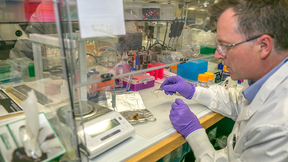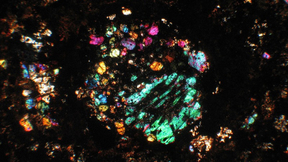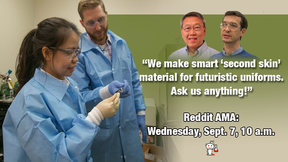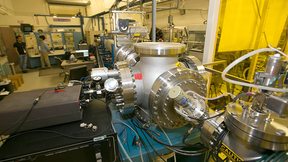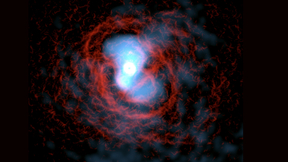Back
Physical and Life Sciences
Researchers explore biomechanical regulation of a key gene in bone
Researchers from Lawrence Livermore National Laboratory (LLNL), in collaboration with Damian Genetos at UC Davis and Alex Robling at Indiana University School of Medicine, investigated a regulatory element for the gene controlling bone mechanoadaptation. Over time, pressure loaded on the skeleton builds bone mass while bone mass is lost from disuse. The sclerostin (Sost)…
DoD awards grant to distinguish aggressive forms of breast cancer that spread in the body
The Department of Defense (DoD) awarded a team from Lawrence Livermore National Laboratory (LLNL) and UC Merced a three-year, $768,803 grant to study breast cancer metastasis. Researchers are on the hunt to identify, characterize and potentially exploit the information packaged in different types of extracellular shed vesicles (ESVs) to determine if they can distinguish…
Livermore scientists purify copper nanowires
Cell phones and Apple watches could last a little longer due to a new method to create copper nanowires. A team of Lawrence Livermore National Laboratory (LLNL) scientists have created a new method to purify copper nanowires with a near-100 percent yield. These nanowires are often used in nanoelectronic applications. The research, which appears in the online edition of…
Laskas dishes on the 'Concussion' controversy
Jeanne Marie Laskas, author of The New York Times best-selling book "Concussion," visited Lawrence Livermore National Laboratory (LLNL) last week, drawing a crowd of more than 200 employees to hear first-hand the sequence of events that led to her book and the subsequent Hollywood movie starring Will Smith. "Concussion," released in 2015, was based on Laskas' 2009 GQ…
Splitting hairs to advance forensic science
With initial help from his work at a Utah university, an Australian-born biochemist is partnering with Lawrence Livermore National Laboratory (LLNL) to discover a second science-based forensic tool for identifying people in addition to DNA profiling. Now an LLNL contract employee, Glendon Parker is working with the Lab's Forensic Science Center employees to develop a…
Laboratory researchers find Earth composed of different materials than primitive meteorites
Scientists from Lawrence Livermore National Laboratory (LLNL) have found that, contrary to popular belief, the Earth is not comprised of the same material found in primitive meteorites (also known as chondrites). This is based on the determination that the abundance of several neodymium (Nd) isotopes are different in the Earth and in chondritic meteorites. A long-standing…
Lab team wins National Institutes of Health two-year grant to develop chlamydia vaccine
Lawrence Livermore National Laboratory (LLNL), with UC Irvine and Synthetic Genomics, won a two-year $485,000 grant from the National Institutes of Health (NIH) to explore new ways to develop a chlamydia vaccine. The team’s project, "Synthetic Generation of a chlamydia Vaccine," uses bioengineering to formulate a major outer membrane protein (MOMP) vaccine. This protein…
Iron springs back to shape under pressure
A team of Lawrence Livermore National Laboratory (LLNL) physicists has performed a series of calculations shedding light on an unexpected way that iron transforms under dynamic compression. In a paper published in Physical Review Letters, the team describes first-principle calculations on two solid phases of iron, as well as on intermediate crystal structures along the…
LLNL-led team develops forensic method to identify people using human hair proteins
In an important breakthrough for the forensic science community, researchers have developed the first-ever biological identification method that exploits the information encoded in proteins of human hair. Scientists from Lawrence Livermore National Laboratory (LLNL) and a Utah startup company have developed the groundbreaking technique, providing a second science-based,…
Ask LLNL's 'second skin' creators anything
Members of the LLNL team that created an environmentally reactive "second skin" for use in military uniforms of the future will be answering questions from the public during a Reddit "Ask Me Anything" online event beginning at 10 a.m. Wednesday. In addition to addressing just about any question on the minds of the Reddit community, Lab scientists Francesco Fornasiero, Ngo…
Lab researchers receive awards from The Meteoritical Society
The Meteoritical Society honored two Lawrence Livermore National Laboratory (LLNL) researchers during their annual meeting that occurred this month in Berlin, Germany. Carolyn Crow, a postdoctoral researcher in the Nuclear and Chemical Sciences Division who studies impact signatures recorded in lunar and terrestrial zircons, won the Gordon A. McKay Award for her…
Scientists identify enzymes that create a highly toxic form of mercury in Antarctic sea ice
Researchers from Lawrence Livermore National Laboratory (LLNL) assisted a team from the University of Melbourne in discovering how methylmercury enters the Antarctic sea and bioaccumulates in the marine food web. LLNL scientists Michael Thelen and Adam Zemla performed protein sequence analysis and structural modeling to predict key proteins involved in mercury methylation…
Lab team uses pulsed ion beams to probe radiation defect dynamics in nuclear materials
Materials scientists at Lawrence Livermore National Laboratory (LLNL) have developed a novel experimental method to access the dynamic regime of radiation damage formation in nuclear and electronic materials. Their approach is based on using pulsed ion beams for measurements of defect lifetimes, interaction rates and diffusion lengths. The creation of stable radiation…
Feeling the force between sand grains
For the first time, Lawrence Livermore National Laboratory (LLNL) researchers have measured how forces move through 3D granular materials, determining how this important class of materials might pack and behave in processes throughout nature and industry. Granular materials such as sand, soil and rice exist everywhere around us. However, scientists and engineers do not yet…
Going beyond 3D printing to add a new dimension for additive manufacturing
A team of Lawrence Livermore National Laboratory researchers has demonstrated the 3D printing of shape-shifting structures that can fold or unfold to reshape themselves when exposed to heat or electricity. The micro-architected structures were fabricated from a conductive, environmentally responsive polymer ink developed at the Lab. In an article published recently by the…
Nuclear forensics program aims for critical mass
A sure sign of summer is the return of interns to the Lawrence Livermore campus. Students interact with premier researchers and access equipment and facilities not available anywhere else, while scientists lay groundwork for advancing their fields. Within the Physical and Life Sciences directorate, the Glenn T. Seaborg Institute runs an eight-week summer internship for…
Lab collaborates with small businesses in gas turbine manufacturing and geothermal projects
Two small businesses working with Lawrence Livermore National Laboratory (LLNL) will receive more than $350,000 for expertise in advanced gas turbine manufacturing and geothermal engineering as part of the Department of Energy’s (DOE) Small Business Voucher (SBV) pilot. With vouchers in hand, these businesses can better leverage the world-class capabilities of the…
New electron microscope expands materials characterization capabilities at Laboratory
A new Transmission Electron Microscope (TEM) installed at the Lab earlier this year is giving LLNL researchers a clearer look at the atomic level of structures than they’ve had before. The Titan 80-300 TEM, manufactured by FEI Company, was installed in December and brings an expanded capability to the existing transmission electron microscope the Lab has had for about 20…
Scientists find de-icing agent remains stable at more than a million atmospheres of pressure
Lawrence Livermore National Laboratory scientists have combined X-ray diffraction and vibrational spectroscopy measurements together with first-principle calculations to examine the high-pressure structural behavior of magnesium chloride. Magnesium chloride (MgCl2) is well known to be an effective de-icing agent, for example, in the aviation industry. Magnesium compounds,…
Team tracks core of massive object in universe
International scientists have identified the dynamics of the core of one of the most massive objects in the known universe, bringing insight into the cosmology of clusters of galaxies. The Hitomi collaboration, in which Lawrence Livermore National Laboratory scientist Greg Brown is a member, found that the turbulent motion of the intracluster gas in the Perseus cluster is…






